Key takeaways:
- Food pairings involve understanding the interaction of flavors and can evoke strong emotions or nostalgia.
- Culinary education enhances creativity, innovation, and the ability to master food pairings through a structured approach.
- Experimentation with flavors, textures, and minimal ingredient combinations is key to discovering memorable pairings.
- Documenting culinary experiences can inspire creativity and track successful flavor combinations over time.
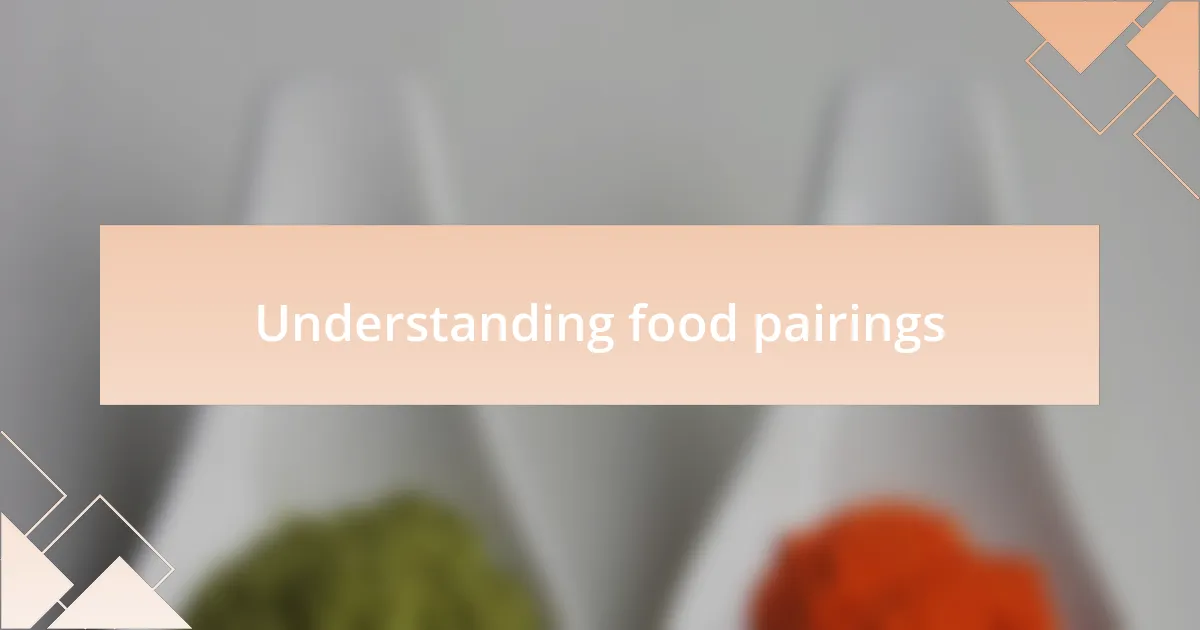
Understanding food pairings
Food pairings are more than just combining ingredients; they involve understanding how flavors interact and complement each other. I remember the first time I paired a rich chocolate dessert with a bold red wine. The experience was enlightening, showcasing how the tannins in the wine cut through the sweetness, creating a balance that was absolutely divine. Have you ever wondered why certain foods just seem to belong together?
When I delve into the science of flavors, I often consider the concept of “flavor compounds.” For instance, basil and tomatoes share similar aromatic compounds, which is why they create that classic Italian harmony. This connection fascinates me, as it opens a world of endless culinary possibilities. Why is it that some combinations evoke such strong emotions or nostalgia?
Another aspect that intrigues me is how cultural influences shape our perception of food pairings. I once attended a dinner where the chef introduced me to the unexpected but delightful pairing of sake with cheese. It challenged my preconceived notions and made me appreciate how food can bridge cultures. Have you ever tasted something that transformed your understanding of what goes well together? Food pairings offer a journey, inviting us to explore and expand our culinary horizons.

Importance of culinary education
Culinary education is vital for anyone looking to master the art of food pairings. Through my own journey, I discovered that the foundation of great cooking lies in understanding the science behind flavors and textures. I recall a class where we experimented with acidity and sweetness; learning that a dash of citrus can elevate even the simplest dish was a revelation. Have you ever tasted a bite that just feels complete? Education equips us with the tools to create those harmonious experiences.
Moreover, culinary education fosters creativity and experimentation. I remember pairing an unexpected ingredient—smoked paprika—with a classic creamy risotto. The flavor burst was mesmerizing, and it was in that moment I recognized how educated instincts allow us to break boundaries. Isn’t it exhilarating to discover a pairing that surprises both your palate and your dinner guests?
Lastly, a structured culinary education enhances one’s ability to innovate. After delving deep into cultural cuisines, I was inspired to blend traditional French techniques with Asian flavors during a dinner party. The result? A deconstructed sushi burrito that left my friends raving for weeks. Isn’t it amazing how education not only teaches us recipes but also cultivates a mindset for exploration and discovery?
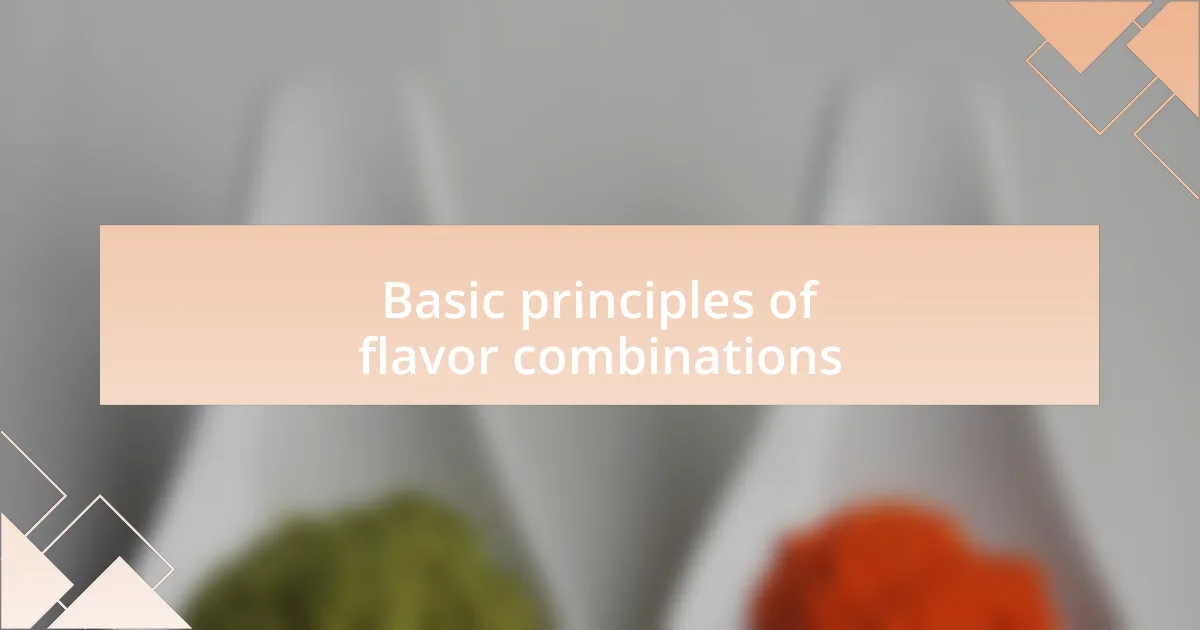
Basic principles of flavor combinations
One of the basic principles of flavor combinations is understanding the balance of taste. I remember the first time I experimented with sweet and salty—it was a simple dessert featuring caramelized nuts atop a creamy cheesecake. The contrasting flavors created an extraordinary depth, making me realize that opposing tastes, when balanced, can truly elevate a dish to new heights. Have you ever found yourself captivated by such a flavor interplay?
Another essential aspect is the role of flavors that complement each other. When I first paired earthy mushrooms with fragrant thyme in a risotto, it was like they were meant to be together. The woodsiness of the mushrooms was beautifully highlighted by the herbaceous notes of thyme. It made me think—how often do we overlook simple ingredients that could enhance each other dynamically?
Lastly, I’ve learned that regional and seasonal ingredients often share harmonious pairings. During a summer trip to the farmer’s market, I discovered ripe tomatoes and fresh basil that sang together in my mind. Bringing those elements together in a Caprese salad was both refreshing and nostalgic. It taught me how important it is to consider not just flavors, but also where and when the ingredients come together. Can you think of a local dish that tells the story of its surroundings?
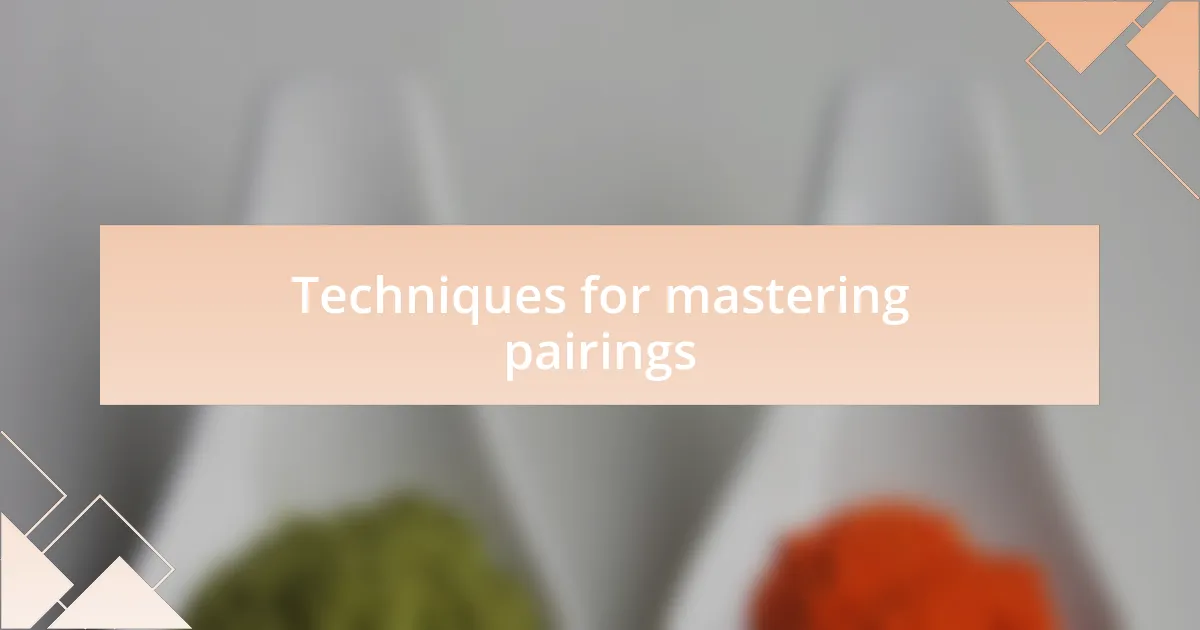
Techniques for mastering pairings
Experimentation is a cornerstone technique in mastering food pairings. I vividly recall a rainy afternoon when I decided to play with acidity and creaminess in my cooking. I paired tangy goat cheese with a drizzle of honey and a sprinkle of lemon zest, and the result was a revelation. It was a moment of pure joy; suddenly, I understood how contrasting elements can create balance. Have you ever experienced that eureka moment in the kitchen?
Another valuable technique is to focus on texture. I once created a dish combining crispy fried shallots with creamy mashed potatoes. The crunch of the shallots added an unexpected layer that elevated the dish, making it not only more enjoyable to eat but visually appealing as well. Isn’t it fascinating how texture can transform our perception of flavors?
Finally, don’t underestimate the power of minimizing your pairings to a few key ingredients. I often experiment with three or four components—such as fresh fish, citrus, and herbs—and find that simplicity can lead to brilliance. I remember a particularly successful dish where just salmon, dill, and lemon came together beautifully. It reminded me that sometimes less is indeed more. What’s your go-to strategy for creating memorable pairings in your kitchen adventures?
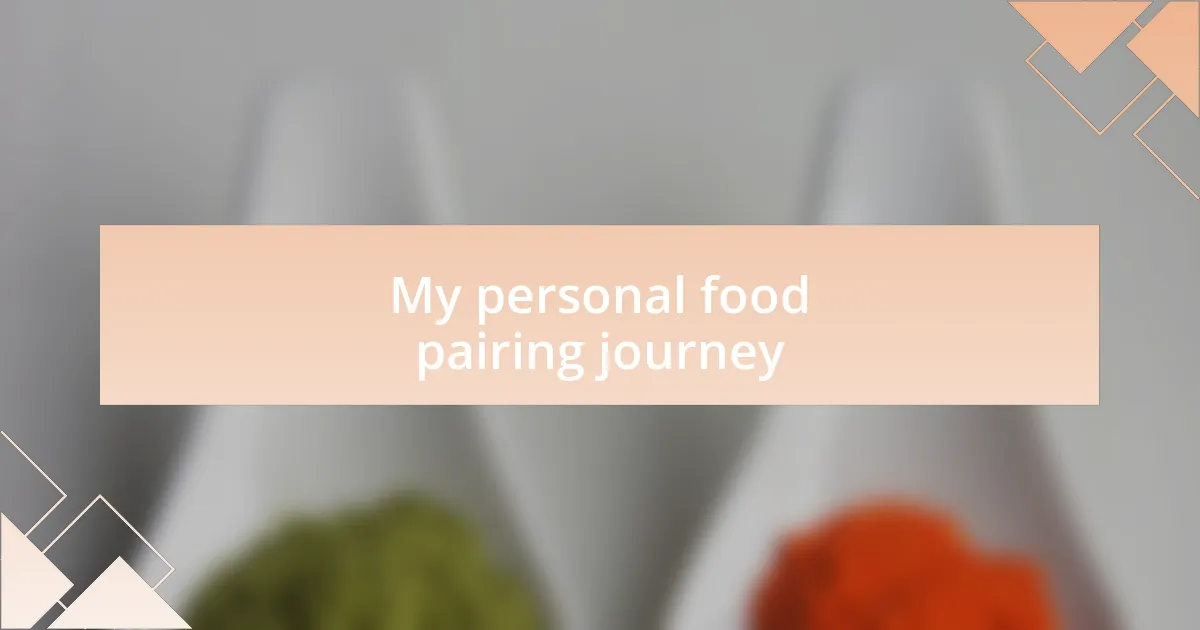
My personal food pairing journey
My fascination with food pairings began long before I had any formal training. I still remember the first time I paired dark chocolate with sea salt; the moment was surreal. The sweetness of the chocolate mingled beautifully with the salty crunch, igniting a spark of creativity in my mind. Has a simple combination ever opened up a whole new world of flavors for you?
As I honed my skills, I found inspiration in unlikely places. One evening at a bustling street market, I stumbled upon a stall selling grilled peaches drizzled with balsamic reduction. The sweetness from the fruit balanced so effortlessly with the tangy notes of vinegar. I couldn’t help but think, why hadn’t I thought of that? It taught me to be receptive to flavors beyond the usual pairings.
A profound realization hit me when I started taking notes on my culinary experiments. I found that documenting my experiences helped me track what worked and what didn’t. One of my breakthrough moments came when I jotted down my favorite pairings of earthy root vegetables with aromatic herbs. I became excited about the storytelling aspect of these flavors. Do you keep a culinary journal? It can be a powerful tool to capture those little notes of inspiration that might otherwise slip away.
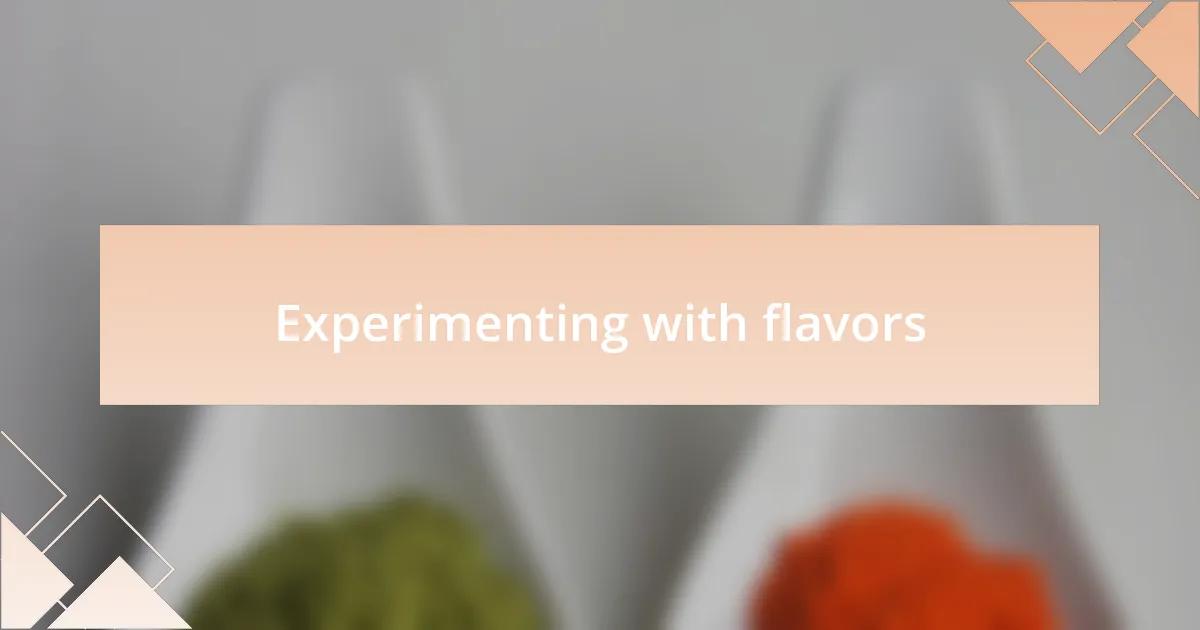
Experimenting with flavors
Experimenting with flavors has often felt like embarking on a thrilling adventure. I vividly recall the day I decided to combine lemon zest with roasted garlic in a simple pasta dish. The bright citrus notes blended with the creamy depth of the garlic, elevating the meal into something memorable. Have you ever discovered a combination that completely surprised you?
One technique that has served me well is adding unexpected spices to familiar dishes. I still remember trying smoked paprika in a typical vegetable stew. At first, I hesitated, wondering if the flavor would clash with the fresh herbs. But, to my delight, it added a smoky warmth that transformed the entire experience. It made me realize that sometimes you just need to take that leap of faith with your palate.
Recently, I tried infusing herbs into oils, paving the way for deeper flavor exploration in my cooking. As I drizzled a basil-infused oil over a caprese salad, the fresh aroma and taste sparked a wave of nostalgia—reminding me of summer picnics with my family. Have you ever experienced a flavor that transported you back in time? Those moments not only enhance the dish but also create lasting memories tied to the experiences they evoke.

Sharing my successful pairings
One of my most successful pairings came during a cozy evening at home when I decided to experiment with dark chocolate and sea salt. I melted the chocolate and drizzled it over freshly sliced strawberries. The sweetness of the fruit balanced beautifully with the rich, slightly bitter chocolate, while the sprinkle of sea salt intensified the flavors. It was a simple yet profound reminder of how a pinch of salt can transform a ordinary dessert into something extraordinary.
Another memorable pairing was when I combined aged balsamic vinegar with fresh peaches. That summer, I had an abundance of both, and the thought struck me to blend their flavors. The syrupy richness of the balsamic brought out the sweetness of the peaches, creating a vibrant salad perfect for warm evenings. Have you ever felt the sheer joy of a dish coming together in a way you never expected? It’s a feeling of accomplishment I cherish with every plate I serve.
Finally, I cannot overlook the magic that happens when saffron meets seafood. I still savor the memory of a paella I crafted one evening. The way the saffron infused the rice with its golden hue and unique flavor amazed me as the aroma filled the kitchen. Each bite was a celebration of flavors that transported my guests and me to the sun-soaked shores of Spain. It’s those culinary moments that remind me of the beauty in pairing ingredients thoughtfully.